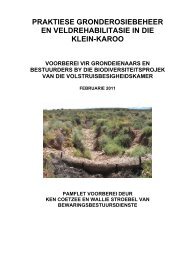REHABILITATION: REHABILITATION: A QUICK GUIDE A ... - saobc
REHABILITATION: REHABILITATION: A QUICK GUIDE A ... - saobc
REHABILITATION: REHABILITATION: A QUICK GUIDE A ... - saobc
You also want an ePaper? Increase the reach of your titles
YUMPU automatically turns print PDFs into web optimized ePapers that Google loves.
2.5 GULLEY AND RILL EROSION<br />
In severely degraded gulley erosion systems, the stream banks were stripped of<br />
their protective plant cover by livestock; presumably they were attractive because of<br />
the more persistent moisture and accumulated nutrients in the alluvial deposits.<br />
Today the banks are eroded and aridified and gullies continue to eat back into the<br />
soil deposits on both sides of the drainages with each rain event in many areas.<br />
Gulley erosion occurs in all of the ostrich rehabilitation camps, in varying degrees of<br />
severity.<br />
In most cases, it is practically impossible to reseed these eroded banks due to the<br />
loss of soil micro-organisms, aridification, steep slope, capping and exposure. The<br />
recommended treatment must stabilize the slopes and provide a more hospitable<br />
environment for rapid and lasting plant establishment.<br />
2.5.1 STEP 1 - REMOVE AND STOCKPILE THE TOPSOIL:<br />
All patches of vegetated topsoil within these erosion areas must be stripped to a<br />
depth of 100 – 200 mm and the topsoil removed to a “safe” site and stockpiled for<br />
re-use. The removal of topsoil can be done with a machine (backacter arm) or by<br />
hand. This topsoil will provide the soil micro-organisms needed to kickstart the<br />
rehabilitation process and the more that is removed and stockpiled, the greater the<br />
chances of a swift and effective plant recovery. (See Appendix 1 for a description of<br />
soil micro-organisms, and in particular, the important micorrhiza).<br />
Topsoil can be stockpiled, preferable with the plant growth still on it, in long heaps<br />
(approximately 3 m long and 800 mm high). Heaps should be no bigger because<br />
air and water penetration will be restricted and the valuable micro-organisms may<br />
be lost. Topsoil stockpiling must take place immediately prior to the following<br />
shaping work because topsoil stockpiling time should be as short as possible, so<br />
that minimal soil organisms are lost, the topsoil must remain “alive”.<br />
2.5.2 STEP 2 – SHAPING THE GULLY SLIDES:<br />
To create a more hospitable environment for plant germination the steep-sided and<br />
eroded river banks and gullies must be reshaped into a more gradual slope. A<br />
slope of between 40 º and 30 º will be ideal. This requires the complete reshaping<br />
of the drainage, on both sides and the effect will be to “flatten” out the banks in<br />
preparation for stabilization and reseeding. (See Figure 6A). It is very important,<br />
however, that the drainage itself remains unobstructed.<br />
The reshaping can be done with a tilted grader blade, a front end loader or a digger/<br />
loader with a backacter arm. The most suitable machine to use will depend on the<br />
size of the bank and degree of reshaping required. In the case of smaller banks<br />
and gullies the shaping can also be done by hand.<br />
Reshaping must also get rid of the dry crumbling and isolated mounds of soil<br />
around which gullies have removed most of the soil. These mounds can be<br />
16



